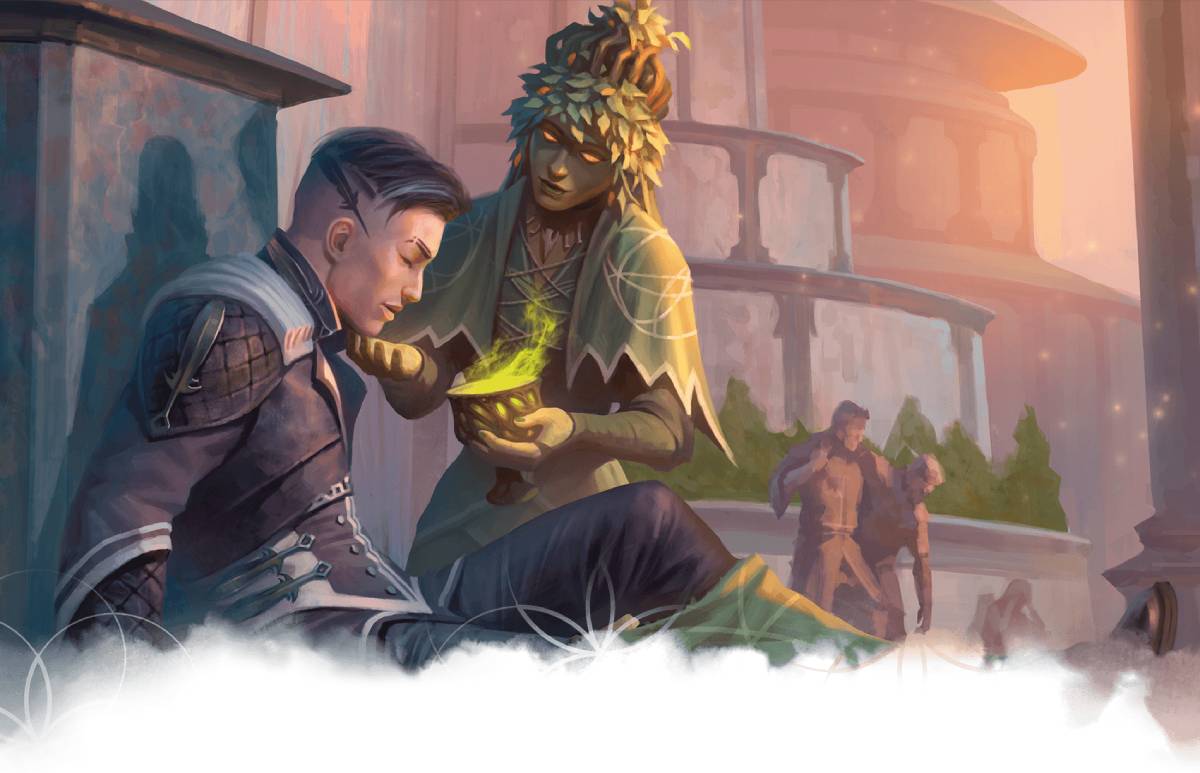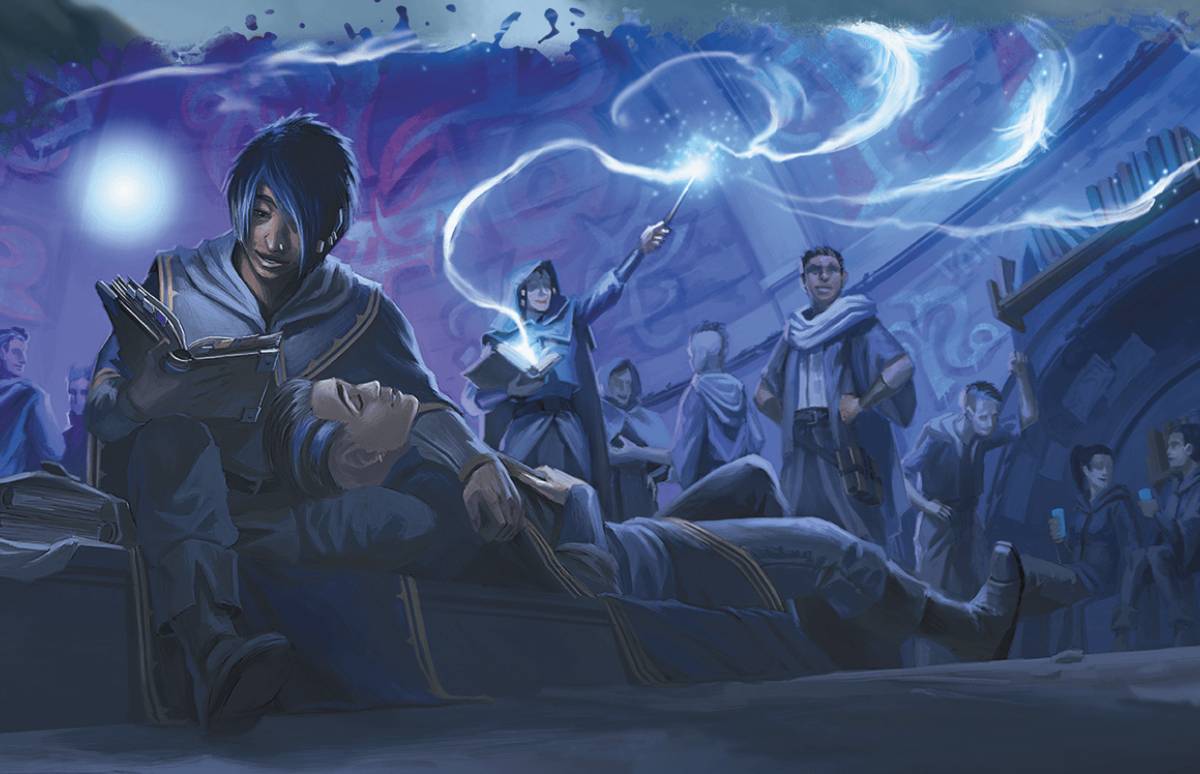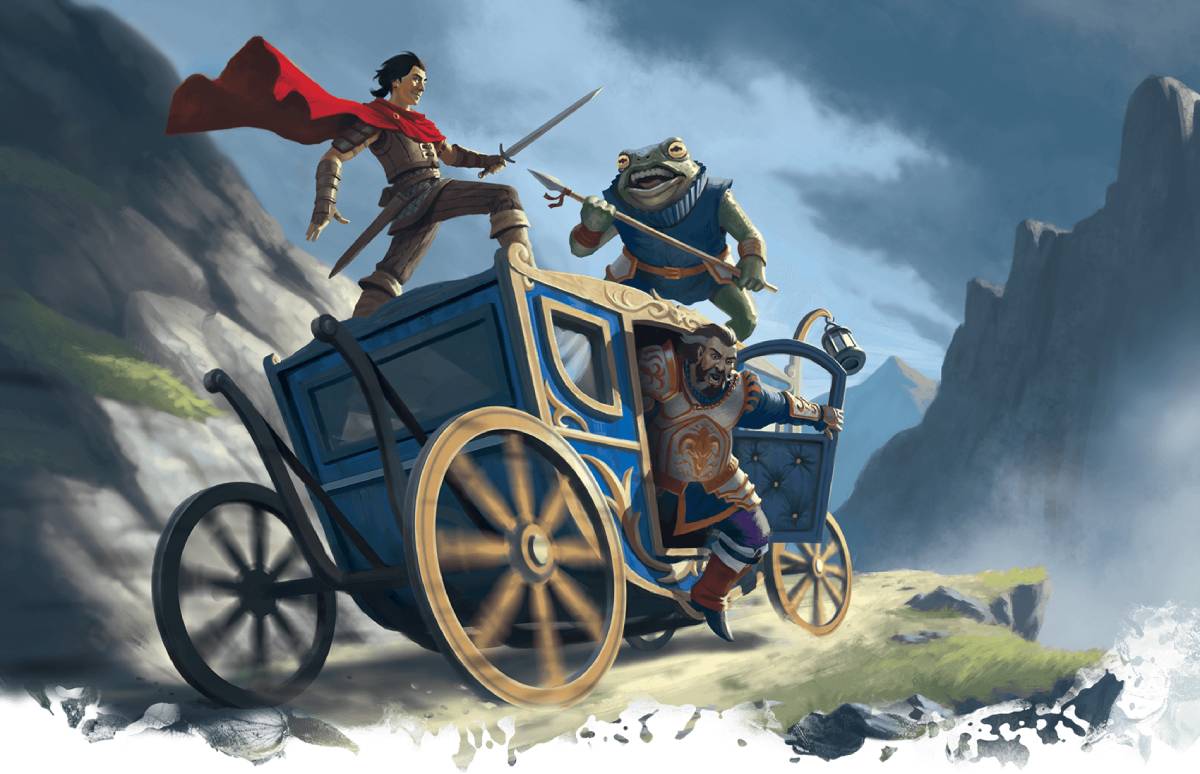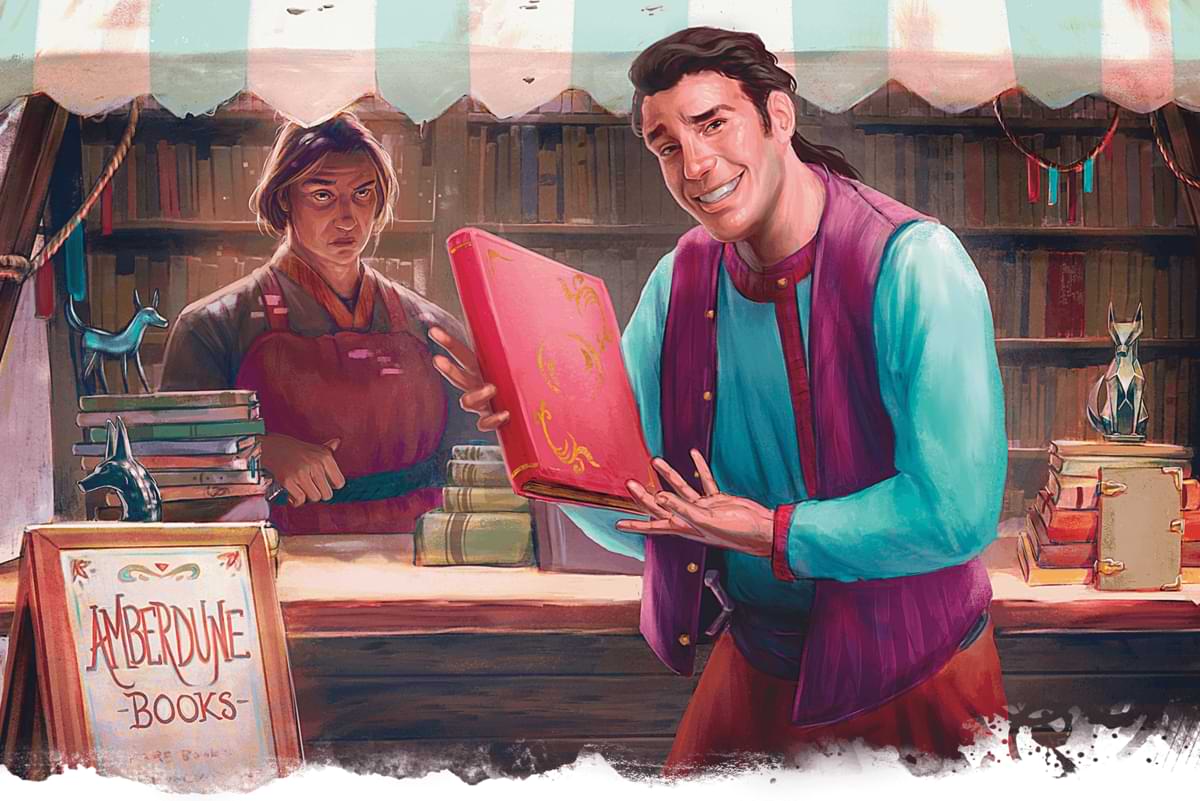One of the coolest parts about Dungeons & Dragons is how every table has their own rules. As a group, you may have spent countless hours embarking on unforgettable adventures, obtaining powerful relics, and exploring the backstories of your favorite characters. But, when it comes to starting your next adventure—whether it's a one-shot or a long-term campaign—you may want to switch up the game's core mechanics to introduce exciting new interpretations of D&D to your table.
There are a number of optional rules found in the Dungeon Master's Guide that are an excellent first step when searching for ways to switch up your D&D game. From varied healing mechanics to methods for dealing with massive damage, these optional rules can turn a high-fantasy system into a gritty, low-magic adventure. Or, you could embellish the "heroic" aspect of heroic fantasy and turn your game into an action-packed anime-style epic! In this article, we'll cover some of these options and provide insight into how they can be used to diversify your D&D game!
A Note On Optional Rules
Before modifying your campaign with these optional rules, it is best to discuss any ideas with your table. At its core, D&D is a collaborative experience, so make certain everyone approves of changes, big or small, that might impact their gameplay.
Healing

To begin, healing is integral to D&D since encountering powerful enemies sometimes results in terrible wounds. There are plenty of spells, potions, and class features that provide players with a way to bring their wounded party members back to fighting shape. Even slightly adjusting this core mechanic can dramatically alter the difficulty and tone of your adventures.
Here are a few alternative healing options from the Dungeon Master's Guide.
Healer's Kit Dependency
The only way characters can heal during a short rest is with a healer's kit, which will allow them to spend Hit Dice. Otherwise, they cannot naturally recover health, which will increase the significance of every point of damage the characters take. Players will have to be more cautious with their decisions in order to survive their next dungeon crawl.
Healing Surges
This optional rule allows characters to spend up to half of their Hit Dice in the middle of combat to heal. This provides a feeling similar to a superhero or anime hero epically recovering from a big blow. The added healing allows characters to engage in more deadly encounters. Instead of waiting until 20th level, a group of prepared characters could potentially go head-to-head with the strongest enemies the Monster Manual has to offer. Alternatively, you can have multi-staged boss battles that offer unique combat scenarios and create unforgettable plot points.
This optional rule is also handy in taking some pressure off the party cleric, who may want to do more than cast cure wounds.
Slow Natural Healing
On the opposite end of the spectrum, Slow Natural Healing takes away the character's ability to fully heal at the end of a long rest. Instead, they are forced to heal with their Hit Dice or any other method available to them. This will require serious resource management, which will add tension to sessions.
Rest Variants

Like healing, the short and long rest mechanics are tools players use to prepare for future encounters. Seasoned adventurers tend to plan when and where they can rest during a difficult adventure. This allows them to manage their resources and ensures they're ready to engage with their next terrifying foe. Implementing the rest variants from the Dungeon Master's Guide can turn the average moderately difficult campaign into a low-risk setting or even a setting where death might come from the next combat encounter.
Epic Heroism
This optional rule switches a short rest to 5 minutes and a long rest to 1 hour. This will alleviate wounds and restore spell slots far more quickly than an average campaign. Using this optional rule, Dungeon Masters can send wave after wave of enemies against the heroes, providing players the unique experience of being legendary warriors.
Gritty Realism
On the other hand, the Gritty Realism variant switches a short rest to 8 hours and a long rest to 7 days. This will increase the difficulty of a campaign since the players will have to seriously consider how to best spend their resources. This is a great option for groups who enjoy low magic settings.
Initiative

In combat, initiative determines the order in which the characters and enemies can act. A high initiative for your party means being able to deal damage or cast spells before enemies can even land a hit and vice versa. This can have serious implications for whichever side doesn't go first.
Speed Factor
In order to add some realism to your sessions, the optional Speed Factor rule offers various modifiers that you can apply to your character's initiative rolls (which happen each round rather than at the beginning of combat). These modifiers take into consideration several factors, such as weapon type as well as creature size. While this may take more time to determine, it can allow DMs to break from the predictable style of the typical initiative mechanics, which can be prone to metagaming. This initiative style is best for strategic, war-style games, where combat can take an entire session.
Speed Factor Initiative Modifiers
| Factor | Initiative Modifier |
| Spellcasting | Subtract the spell's level |
| Melee, heavy weapon | -2 |
| Melee, light or finesse weapon | +2 |
| Melee, two-handed weapon | -2 |
| Ranged, loading weapon | -5 |
| Creature Size | Initiative Modifier |
| Tiny | +5 |
| Small | +2 |
| Medium | +0 |
| Large | -2 |
| Huge | -5 |
| Gargantuan | -8 |
Damage

The danger of encountering powerful villains who wield powerful magic makes for memorable moments in D&D. To make every battle feel even more dangerous, the damage variant rules from the Dungeon Master's Guide can really up the ante. These options introduce the concept of long-lasting injuries and potentially lethal effects that might occur when a creature takes a tremendous amount of damage in a single hit.
Injuries
Usually, a character in D&D can be reduced to 1 hit point and be just as effective as if they were at full health. If your group is looking to add more realism to their campaign, this rule variant provides a list of injuries that can be obtained in the following ways:
- When a creature takes a critical hit.
- When a creature drops to 0 hit points but isn't killed outright.
- When a creature fails a death saving throw by 5 or more.
Once you have determined that a character has sustained an injury, the player can roll a 1d20 to see what kind of injury they receive and what the mechanical effect is.
Lingering Injuries
| d20 | Injury |
| 1 | Lose an Eye. You have disadvantage on Wisdom (Perception) checks that rely on sight and on ranged attack rolls. Magic such as the regenerate spell can restore the lost eye. If you have no eyes left after sustaining this injury, you're blinded. |
| 2 | Lose an Arm or a Hand. You can no longer hold anything with two hands, and you can hold only a single object at a time. Magic such as the regenerate spell can restore the lost appendage. |
| 3 | Lose a Foot or Leg. Your speed on foot is halved, and you must use a cane or crutch to move unless you have a peg leg or other prosthesis. You fall prone after using the Dash action. You have disadvantage on Dexterity checks made to balance. Magic such as the regenerate spell can restore the lost appendage. |
| 4 | Limp. Your speed on foot is reduced by 5 feet. You must make a DC 10 Dexterity saving throw after using the Dash action. If you fail the save, you fall prone. Magical healing removes the limp. |
| 5–7 | Internal Injury. Whenever you attempt an action in combat, you must make a DC 15 Constitution saving throw. On a failed save, you lose your action and can't use reactions until the start of your next turn. The injury heals if you receive magical healing or if you spend ten days doing nothing but resting. |
| 8–10 | Broken Ribs. This has the same effect as Internal Injury above, except that the save DC is 10. |
| 11–13 | Horrible Scar. You are disfigured to the extent that the wound can't be easily concealed. You have disadvantage on Charisma (Persuasion) checks and advantage on Charisma (Intimidation) checks. Magical healing of 6th level or higher, such as heal and regenerate, removes the scar. |
| 14–16 | Festering Wound. Your hit point maximum is reduced by 1 every 24 hours the wound persists. If your hit point maximum drops to 0, you die. The wound heals if you receive magical healing. Alternatively, someone can tend to the wound and make a DC 15 Wisdom (Medicine) check once every 24 hours. After ten successes, the wound heals. |
| 17–20 | Minor Scar. The scar doesn't have any adverse effect. Magical healing of 6th level or higher, such as heal and regenerate, removes the scar. |
Massive Damage
To make combat play out faster and more dangerous, this rule variant introduces the concept that when a character takes a great deal of damage, they suffer a devastating shock to their system. This triggers when a creature takes damage from a single source equal to or greater than half its hit point maximum. If they do not succeed on a DC 15 Constitution saving throw, they must determine the System Shock effect.
Although this might seem harsh, it could be beneficial to groups who wish to experience the threat of a one-hit kill. That said, it certainly works better for groups planning on starting at a higher level, as 1st-level characters would be susceptible to succumbing to these effects.
System Shock
| d10 | Effect |
| 1 | The creature drops to 0 hit points. |
| 2–3 | The creature drops to 0 hit points but is stable. |
| 4–5 | The creature is stunned until the end of its next turn. |
| 6–7 | The creature can't take reactions and has disadvantage on attack rolls and ability checks until the end of its next turn. |
| 8–10 | The creature can't take reactions until the end of its next turn. |
Plot Points

Even with an Oscar-worthy heartfelt speech, convincing a villain to turn away from the path of evil can be difficult, especially when you rolled low on your Persuasion check. This is where Plot Points shine as they offer players the power to influence the sessions in major and minor ways.
Using Plot Points
Each player starts with 1 plot point that they can then spend on one of the following options that will impact the story. This provides them additional agency to steer the campaign in a direction they would enjoy.
It is always beneficial to confirm with your group if the way you intend to use your plot point is acceptable. That way, it isn't used to undermine others at the table.
Option 1: What a Twist!
With this option, the player can summon a reasonable physical object or element that can assist the group in moving forward, such as a merchant selling the exact item the group needs or a distinct marking on a floor leading to a trap door.
Option 2: The Plot Thickens
This builds on our first option. When a player spends a plot point for an effect, the player to their right adds a complication. Perhaps you spend a plot point to have your bitter rival appear at the same tavern. The player to your right may determine that the rival is best friends with the tavern owner, and is therefore in a position of power.
Option 3: The Gods Must Be Crazy
This wild card of an option allows for swapping the Dungeon Master with another person. This will create sessions filled with unexpected results to the benefit or dismay of the group.
Time to Spice Things Up
Although we covered quite a few optional rules, the Dungeon Master's Guide offers many more rules variants. Be sure to crack open your own books or look them up on D&D Beyond to see what other aspects you'd like to add to your campaign!
DeAngelo Murillo (That_DeAngelo) is a fourth-generation Mexican-American who helps bring more representation to the geeky community through storytelling, journalism, interviewing creatives, and more on his Twitch channel. In his free time, he enjoys harassing his peers into participating in TTRPG charity events with him and also dies quite often in video games.








-
View User Profile
-
Send Message
Posted Apr 25, 2023All great ideas! Thanks so much!
-
View User Profile
-
Send Message
Posted Apr 25, 2023All I’m saying is people should really just read the DMG
-
View User Profile
-
Send Message
Posted Apr 25, 2023Really wish dnd beyond supported the spell point system, it’s perfect for sorcerers.
-
View User Profile
-
Send Message
Posted Apr 25, 2023It would be nice if D&D Beyond supported any of these; it's tough to use variant long rests when the D&D Beyond long rest button always auto-heals, so to do it you'd have to have players manually uncheck everything they've used (and nobody's going to want to do that).
Likewise with spell points and a bunch of other really cool features that D&D automation could make a lot easier to use.
I'm a fan of plot points, but you have to add a feat or something to make it easier to track.
-
View User Profile
-
Send Message
Posted Apr 25, 2023I don't really want to take the time picking each of these apart.
Some are close to being interesting but miss the mark.
I've seen more interesting mechanics from the community at large, like dropping to 0hp then being revived gives level(s) of exhaustion to simulate the fact that you're not just bouncing back from a near-death experience, pretty much all of Brennan's mechanics from Dimension 20. His "Roll a Con on a blow that takes more than 1/2 your HP" is a better take on the "Injuries" section from this, for example.
Good thinking points to adapt and integrate for sure, but I wouldn't run any of these as written at my table tbh.
-
View User Profile
-
Send Message
Posted Apr 25, 2023I've never liked that as a house-rule, as it just penalises the characters that are already having the worst time; in a properly functioning party it's not surprising if the tank goes down from time to time in really tough fights, and you shouldn't punish them for doing what they're supposed to be doing (keeping their allies from getting hit). Healing in D&D 5e isn't about keeping players up, it's about getting them back up when they go down, because it's just not cost effective to try and stay topped up.
I actually prefer lingering injuries for this, but you should hand them out narratively, or when a player does something dumb, i.e- when going down is their own fault.
-
View User Profile
-
Send Message
Posted Apr 25, 2023This is a great article and really shows the wealth of information in the DMG.
-
View User Profile
-
Send Message
Posted Apr 25, 2023I would LOVE to be able to incorporate these various optional rules on DNDBEYOND!!! Please give us DMs the ability to do so.
-
View User Profile
-
Send Message
Posted Apr 25, 2023While I understand the thoughts, this, at least for me isn't about punishing players. It is about trying to create more realistic consequences that death and on the verge of death is taxing. Along with, trying to keep the meta from happening. In many cases, players will be like "Oh, I've got three rounds before I have to realistically worry about the downed person. Let me just continue without them, kill the monster, then worry about the person that went down." While that might be valid, it takes away from the overall moment and makes it to where going down is a speed bump, not an actual critical junction. It should be a critical junction, regardless of if they were doing what they are supposed to be doing. Having no consequences from going down takes away from the realism and breaks immersion for many folks. Myself included. Again, for me, it isn't punishment, it is just adding another dynamic level of play. I also understand it isn't for everyone.
-
View User Profile
-
Send Message
Posted Apr 25, 2023The issue with most of these variant rules is they're not supported for shit on the DDB character sheet. My table's tried to use Slow Natural Healing multiple times in the past, but DDB's insistence that all long rests MUST fully recover every last single hit point makes it incredibly frustrating to try and use. It sucks, and I strongly wish DDB could be better about it.
-
View User Profile
-
Send Message
Posted Apr 25, 2023To be honest, in my opinion using Plot Points #3 sounds terrible and disrespectful towards the efforts of the DM, that planned the session. Even if I give my players this rule I would probably still feel offended if they used it.
10/10 wouldn't recommend.
-
View User Profile
-
Send Message
Posted Apr 25, 2023And the Player's Handbook. I can't count how many times I've seen someone ask Jeremy Crawford on Twitter questions that could be answered if they just cracked either book open once.
-
View User Profile
-
Send Message
Posted Apr 25, 2023All so true. If DDB supported any of these rules it would be great, but especially Spell Points and Slow Healing. I wonder if this article means it might actually happen at some point. Like, ever.
-
View User Profile
-
Send Message
Posted Apr 25, 2023Tell me about it. Even if all they read were chapters 7, 9, and 10 of the Basic Rules (not even the PHB, just the free basic rules), things would be so much easier for both them and their DMs. 🙄
-
View User Profile
-
Send Message
Posted Apr 25, 2023"Slow Natural Healing takes away the character's ability to fully heal at the end of a long rest. Instead, they are forced to heal with their Hit Dice or any other method available to them."
So...so if they have to use hit dice to heal during a long rest...when do they get the hit dice back?
-
View User Profile
-
Send Message
Posted Apr 25, 2023I know. People should read the books.
You should NEVER Dm without reading the PhB and DMG. EVER.
-
View User Profile
-
Send Message
Posted Apr 25, 2023At the end of the long rest, same as usual.
-
View User Profile
-
Send Message
Posted Apr 25, 2023Meh, I am currently wrapping up a spelljammer themed campaign and I have never read the DMG, or even all of the PHB. I just reference the things I need, and make up the rest. My players and I seem to be having a lot fun with it.
-
View User Profile
-
Send Message
Posted Apr 25, 2023The problem is that, at least in my experience, even in a properly functioning party the same characters are usually the ones that go down; if you've got a tank then they're going to take a load of damage, and going down is a definite possibility if they're tanking properly (it's to be expected), because there are limits to how fast the party can heal them to keep them up, and also limits to how much they should as bringing the monster down is usually a better move.
If you start mechanically punishing the party's tank for being the party's tank, then they're not going to want to do that anymore.
Again this is why I prefer DM adjudicated injuries for players doing something unwise; it means the "incorrect" actions can have consequences rather than the "correct" ones. You could do it with exhaustion I guess, but exhaustion isn't a major penalty for most, and again penalises certain characters more than others; having disadvantage on checks is a huge penalty for the party's bard, who might have just got hit with an unlucky critical hit and gone down, whereas the party's barbarian who keeps jumping head first off every cliff they encounter probably doesn't care about exhaustion till at least the second level.
-
View User Profile
-
Send Message
Posted Apr 25, 2023I can see others looking these, but most sounds like they're only good if the party wants to have a harder time. I mean, imagine playing a Wizard at level 1 and you get hit once, get a 1 on system shock so now you're dying, then roll a 2 and lose a hand, roll a single bad death save and suddenly lose your other hand. Now you have a worthless character because you got unlucky.
Slow/fast healing would matter only if you make time a very important feature. And the HD on long rest thing means you need magical healing a ton, just like older editions. Healers kits are also cheap so I can't imagine forcing the party to bring them for short rests will do much.
Plot point option number 3 only sounds good for a chaos based one shot and that's IT. Any other situation and it's a bad idea.
Speed factor just sounds like punishing players for not being finesse weapon users. That, or the entire party ends up lumped into one long sequence of turns before the enemy gets their long sequence of turns. The shifting init stops shifting after a few rounds when the party has bottomed out their init via just playing their character's.
But, these are all opinions from a guy who's never used any of these, and never intends on using any of these. I can see why others would enjoy it, but it's not for me